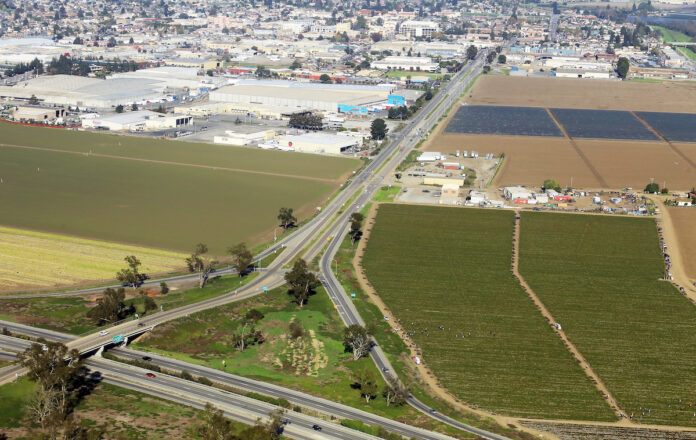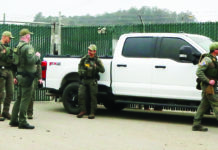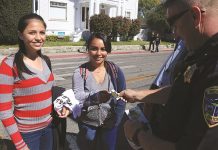
WATSONVILLE—This fall, Watsonville voters face a decision that has been 20 years in the making. Should the city’s urban growth restrictions put in place in 2002 be extended through 2040, or should residents and their elected leaders have an opportunity to determine how and where Watsonville might grow?
Those are the competing visions of Watsonville’s future that have been placed before voters on the Nov. 8 ballot.
Measure Q, also known as the “Planned Growth and Farmland Protection Initiative Measure,” proposes an 18-year extension of a so-called Urban Limit Line (ULL) approved by voters in 2002 that preserved agricultural land by establishing a 25-year growth plan for housing and economic drivers.
Measure S, also known as the “Planning for Watsonville’s Future Measure,” also proposes an 18-year extension of the ULL, but, importantly, would allow the Watsonville City Council to make adjustments to the boundary during its upcoming general plan update, a massive, multi-month undertaking in which the community will determine what Watsonville should strive to be by 2050.
The measures only require a simple majority for approval. If both are approved, then the measure with the most votes will win. In addition, they both could fail.
How did we get here?
Some of the growth restrictions baked into Measure U, which was an amendment to the Watsonville 2005 General Plan, are set to expire this year. And the rest sunset in 2027.
Last year, a group spearheaded by a handful of local farmers and environmentalists gathered some 2,400 verified signatures from registered Watsonville voters to propose the 18-year extension of Measure U’s restrictions. The City Council then approved the signatures and placed the item on the ballot.
Since then, that collective—known as the Committee for Planned Growth and Farmland Protection—and the City Council have clashed on various occasions. The biggest disagreement came when the City Council in a split 4-3 vote tossed out a compromise between the city and committee that would have allowed Watsonville to possibly annex and develop a 13.6-acre agriculture field at 320 Lee Road—better known as the Redman House property on the west side of Highway 1.
In their next meeting, the City Council voted, again via a 4-3 decision—with Mayor Ari Parker and councilmembers Jimmy Dutra and Rebecca Garcia casting dissenting votes—to place what would become Measure S on the ballot.
The Argument for Measure Q
As the committee began its signature-gathering process in early 2021, the message its members told potential signees was simple: “Do you want Watsonville to become San Jose?”
Committee member Sam Earnshaw, a farmer turned environmentalist, says that he remembers the fertile farmlands that covered the area before tech and venture capitalists took over the region and formed the Silicon Valley of today.
“The same can happen here,” Earnshaw said.
Proponents say that approving Measure Q is the only way to stop that. And, they add, if Measure Q is approved, Watsonville would join dozens of cities across California in halting outward growth and instead focusing on infill development to achieve their housing and economic goals.
It was this concept—centering around the conservation of the Pajaro Valley’s rich farmland that is a key component of the Central Coast’s billion-dollar agriculture industry—that Measure U was based on. Twenty years ago, the community came together under the nonprofit Action Pajaro Valley to design the landmark ballot measure in a way that would address the housing affordability and unemployment rate crises Watsonville faced following the approval of the North American Free Trade Agreement in the 1990s.
Measure U identified parcels on the edges of the city that would be annexed into Watsonville’s footprint for housing and job creation. This included the older adult villages off Bridge Street, the land between Crestview Drive and Atkinson Lane currently being developed into affordable housing and the Manabe-Ow (then Manabe-Burgstrom) commercial area where FedEx currently operates. And, along with overtaking those properties, the city would support the redevelopment of underutilized and vacant properties within city limits.
Committee member Bob Culbertson, a board member of the Watsonville Wetlands Watch, says the city has done an admirable job of championing infill development. He points to the numerous projects that are under construction within Watsonville city limits—more than 250 units will be completed by the end of next year alone—and the ongoing Downtown Watsonville Specific Plan efforts that could add nearly 4,000 housing units to the corridor over 25 years.
And, he adds, state legislators and the governor have shown a new resolve to remove barriers for infill redevelopment, limit suburban sprawl and address climate change by creating walkable communities. This includes two new bills signed into law this year that allow developers to build housing on lots zoned for commercial uses, taking much of the power away from Californians that have for years used concerns about community character as a way to block housing production.
Citing city housing and planning documents, the committee says there are dozens of empty or underutilized properties throughout Watsonville that they say are primed for development—a claim city staff has pushed back on—and that the municipality should work with the owners of these properties to spur more housing development.
“There is still a lot of opportunity (sites) throughout Watsonville,” Culbertson said.
One site that Culbertson highlights is the shopping center that houses the Kmart building that has sat vacant since last August. He says that redeveloping these struggling commercial sites into mixed-use developments that include commercial and residential properties could not only spur economic growth but help the city meet its mounting state-mandated housing goals—Watsonville will be tasked with accommodating 2,053 housing units by 2031 alone.
And Culbertson says the city’s promises that annexation will equal jobs are not guaranteed. He points to the Manabe-Ow property that was estimated to bring a maximum of 2,100 jobs when Measure U was developed. FedEx has around 200 employees, and two other parcels on the property set to be developed into distribution centers would bring in another 135, according to the early estimations.
But the committee’s main argument, the preservation of ag land, is what they’d like voters to keep in mind when they fill out their ballots. The soil around the Pajaro Valley is amongst the most fertile in the world and the cool coastal climate found on the Central Coast makes the area a key location for the agriculture industry, which, along with the hospitality industry, is the second largest economic driver in Santa Cruz County.
According to the Santa Cruz County Agricultural Commissioner’s 2021 crop report, the total gross production value of Santa Cruz County agricultural commodities last year was $657.3 million. That figure does not reflect the total contribution of agriculture to the economy. Farm employment and other farm-related services also add significant value and benefits to the local economy such as hotel stays, increased foot traffic for local restaurants, agriculture equipment rentals and trucking and transportation.
Earnshaw and Co. say it would be a travesty for the Pajaro Valley to lose its foothold as an agricultural hub.
“This is special land that provides food and provides jobs,” Earnshaw said. “This is the character of Watsonville.”
The Argument for Measure S
City Councilman Eduardo Montesino says that Watsonville voters should ask themselves one question before they cast their vote on the measures: “Are you happy with the last 20 years?”
Both he and fellow councilman Francisco “Paco” Estrada say that while Measure U’s growth restrictions might not be the only reason why Watsonville has struggled to address its housing and economic woes, they are certainly a big factor.
For one, Montesino says, the inability to annex any unincorporated land for housing has severely hamstrung the city’s ability to provide parcels ideal for new single-family homes. The majority of the projects in the pipeline in Watsonville, including the planned growth downtown, will be multi-story apartment complexes.
“That helps get people housed but it doesn’t give our residents a chance to buy a home and build generational wealth,” Montesino said, adding that it has been nearly two decades since the last for-sale housing project was completed in Watsonville. “That’s an issue. How can we provide a path for our residents to buy a home if they’re not being constructed?”
And, Montesino adds, a key portion of Measure U has never been realized: The development of Buena Vista. Around 2,000 homes, as well as new commercial developments and open spaces and parks, were supposed to be built in the northern reaches of the city. But because the city was successfully challenged in court on its 2030 general plan by the Watsonville Pilots Association, this area is currently deemed off-limits for development—and city staff has said it has no plans to pursue development there.
Montesino says this failure should serve as an example of the challenges that Watsonville will face in accommodating its residents’ needs without any planned outward growth for the next 18 years. And, he adds, Watsonville residents need to be better informed about these challenges before making a decision that will drastically impact the community for two decades. Undergoing the general plan update process, which is scheduled to begin in the coming months, is the right way to get a pulse on the community’s priorities, he says.
“We have challenges in developing housing and bringing jobs. It’s not as simple as saying ‘There’s that vacant lot. Go build something on it,’” he said, adding that many of the vacant lots are empty for a reason—whether it be proximity to the airport and wetlands or issues with zoning. “We need our community to have a say on what they’d like to see in their city.”
Still, both Montesino and Estrada say that they believe the city and the committee are not that far apart in their vision of Watsonville’s future. Both said that it would be silly to believe the city wants to pave over a significant portion of the Pajaro Valley’s farmland that is largely responsible for South County’s culture and character. But, Montesino adds, the agriculture industry is slowly changing and the city should be able to pivot along with it. Specifically, he cites Driscoll’s fast-growing operations in Mexico, its recent investment into vertical farming and the continuous push to automation.
“If they phase us out, that’s fine,” Montesino said. “But if we can do organics, that puts us at another level. There’s a lot of potential for us to work together, and by doing so we can provide a better decent wage so people can be able to have the opportunity to own a home.”
Estrada says that there might not be a bigger equity issue in the county than the decision between the two measures. He points out that the committee has received more than $40,000 in campaign contributions this year, compared to the $99 reported by the Measure S committee. Measure Q donors include powerful figures and businesses in the agriculture industry such as Live Earth Farms’ Tom Broz ($12,000), Lakeside Organic Gardens ($2,000) and Bruce Rider & Sons’ Jim Rider ($2,500)
He questions why the committee is happy with taking money from “big ag,” and not asking them to address issues that he says their industry has had a hand in producing.
“Why don’t they make these demands of ag?” Estrada said. “Why aren’t they asking ag to put more infill worker housing? Why aren’t they demanding that they pay a living wage or to maybe have a new model of economic partnership? Something where even the pickers can build some wealth by the labor that they do … There’s a lot that they can do to help people here but I don’t think the committee makes these demands of the private sector. They definitely make these demands of the public sector, which is fine … but I think we should also ask others who have contributed to this issue to help out a little bit. It would benefit everybody, really.”
But the main reason Estrada says he opposes Measure Q is that he believes the committee did not get the community’s input before proposing the measure. So while they gathered the signatures needed to place the item before the voters, Estrada questions why the committee would champion an agreement from 20 years ago rather than come back to the table and genuinely reassess Measure U’s success and failures, including its impact on Watsonville’s underrepresented Latino population.
“[Measure U has] contributed to some of the larger issues we have that, again, I’d really like to know what their thoughts are, like race and how communities of color have historically been excluded from the decision-making process,” Estrada said. “Two thousand-two seemed like such a remarkable year because it was such an inclusive process. And then we come back to 2022 and it seems like the old days when groups would say, ‘Here’s the law. We’ve figured it out. You all just have to vote on it.’ I would hope that [the committee] would understand that the better process, the one that builds more consensus and buy-in, is when we come together and have shared agreements and goals and we can hold ourselves accountable. But not like this.”
Added Montesino: “Neither them or us are winning by having competing measures.”











Why not include an argument for neither?
OK.
If you made it that far, the article provides an argument for both. Journalism would include the third option available. Try to keep up.
Good idea. No on both. Start again. (if you must, choose S over Q, though)
I support measure Q, somewhat reluctantly. I do not want to give the city council a free pass to do whatever they feel is needed to create low cost housing. I agree with Jimmy Dutra, that building housing that includes poisoned topsoil is not a bargain. increased risk of cancer just to get CRUSTVIEW ESTATES is not worth it. we still have many parcels of land within the original boundaries of Measure U that can be redeveloped to create low cost housing. one example close to my home is the parcel that sits next to Staff of Life on East Lake avenue.
and while i understand why Mayor pro tem Montesino opposes an airport within city limits, I disagree. to remove an established municipal airport would be a step backward, and it would indicate Watsonville has given up on the 21st century. The airport brings needed tourism and potential trade from people with money and are looking for markets to expand. We need our farmland to continue in full production to produce the great bounty of food that makes Watsonville famous. We do not want to be Salinas, we do not want to be San Jose, we do not want to be LA or Orange County. Vote yes on Measure Q.
The only thing that would have the potential to actually lower the cost of housing is to build enough supply but when land available for building is restricted or ‘set aside’ the strategy used for decades in Santa Cruz and other coastal counties the cost of the land has a huge impact on housing cost. ‘Affordable’ housing is not ‘low cost’, it’s very high cost, with others than the residents paying that cost. It is NO solution.
Agriculture is the backbone of California’s economy.
We’ve ran just about every other productive “industry” out of the state.
Let’s not allow easier access to develop over our prime farmland!!!
First of all, AG is actually a surprisingly small part of the overall California economy and despite the numbers touted here for the county the contribution to poverty, housing shortages (prices), water and a true crisis in education (figure it out) are all greatly exacerbated by local ag, particularly since the overall surge in berries. There is a cost benefit analysis that could illuminate this debate.